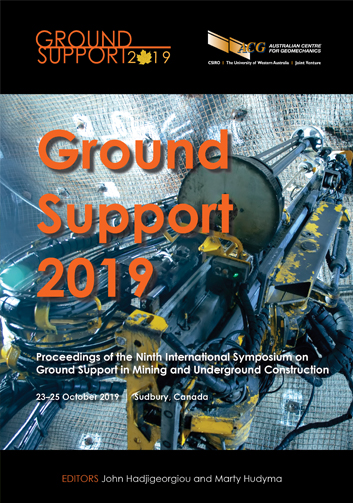Limitations of standard analytical methods of shaft liner design

|
Authors: Hentrich, N-A; Calderon, DS; Bock, S; Franz, J |
DOI https://doi.org/10.36487/ACG_rep/1925_31_Hentrich
Cite As:
Hentrich, N-A, Calderon, DS, Bock, S & Franz, J 2019, 'Limitations of standard analytical methods of shaft liner design', in J Hadjigeorgiou & M Hudyma (eds), Ground Support 2019: Proceedings of the Ninth International Symposium on Ground Support in Mining and Underground Construction, Australian Centre for Geomechanics, Perth, pp. 445-458, https://doi.org/10.36487/ACG_rep/1925_31_Hentrich
Abstract:
Several technical standards for mine shaft lining design have been developed over the past century, especially in countries that have constructed a high number of underground mines. These standards apply different design approaches and consequently, provide the designer with different results. Based on analytical or empirical methods, they give guidance to dimension shaft liners under consideration of the effect of the main factors influencing their stress-strain state. In the engineering practice, such shaft lining design standards are often extended or complemented with other analytical methods, such as the convergence-confinement method, which evaluates the influence of the excavation process and the unsupported shaft section. This paper presents an overview of the most popular standards used for shaft lining design, comparing their consideration of various factors, such as the non-circularity of the shaft geometry, nonuniform lining load, anisotropic ground pressure, water pressure distribution, design life, temporary rock support, temperature load and different lining types. Furthermore, the limitations of these methods are discussed taking into account different approaches for groundwater control (e.g. ground freezing) or shaft sinking methodology (drill and blast, mechanised sinking etc.). A case study is performed, in which the lining of the Victoria mine shaft is dimensioned according to three existing standards, obtaining a wide range of results. The applicability of these standards for this shaft is found to be limited. Proposals are made regarding future work to further improve the shaft lining design, to also include the possibility of using numerical approaches and their compatibility with analytical standards.
Keywords: analytical, standards, DIN, SNIP, PN, shaft lining design, limitations
References:
Carranza-Torres, C & Fairhurst, C 2000, ‘Application of the Convergence-Confinement method of tunnel design to rock masses that satisfy the Hoek-Brown failure criterion, Tunnelling and Underground Space Technology, vol. 15, no. 2, pp. 188–213.
Eisenstein, Z & Branco, P 1991, ‘Convergence-Confinement method in shallow tunnels’, Tunnelling and Underground Space Technology, vol. 6, no. 3, pp. 343–346.
European Committee for Standardization, Eurocode 0 – Basis of Structural Design (EN 1990), European Committee for Standardization, Brussels.
European Committee for Standardization, Eurocode 1 – Actions on Structures (EN 1991), European Committee for Standardization, Brussels.
European Committee for Standardization, Eurocode 2 – Design of Concrete Structures (EN 1992), European Committee for Standardization, Brussels.
European Committee for Standardization, Eurocode 3 – Design of Steel Structures (EN 1993), European Committee for Standardization, Brussels.
European Committee for Standardization, Eurocode 4 – Design of Composite Steel and Concrete Structures (EN 1994), European Committee for Standardization, Brussels.
European Committee for Standardization, Eurocode 6, Design of Masonry Structures (EN 1996), European Committee for Standardization, Brussels.
European Committee for Standardization, Eurocode 7 – Geotechnical Design (EN 1997), European Committee for Standardization, Brussels.
European Committee for Standardization, Eurocode 8 – Design of Structures for Earthquake Resistance (EN 1998), European Committee for Standardization, Brussels.
Fabich, S, Bauer, J, Rajczakowksa, M & Switon, S 2015, ‘Design of the shaft lining and shaft stations for deep polymetallic ore deposits: Victoria mine case study’, Mining Science, vol. 22, pp. 127–146.
Deutsches Institute für Normung e.V. (DIN) 2017, Shaft Sinking in Mining – Design and Dimensioning (DIN 21500:2017-05), Deutsches Institute für Normung e.V., Berlin.
Polski Komitet Normalizacyjny (PKN) 1997a, Szyby górnicze, Obudowa, Zasady projektowania (Mine shafts, Lining, Principles of designing) (PN-G-05015), Polski Komitet Normalizacyjny, Warsaw.
Polski Komitet Normalizacyjny (PKN) 1997b, Szyby górnicze, Obudowa, Obciążenia (Mine shafts, Lining, Loads) (PN-G-05016), Polski Komitet Normalizacyjny, Warsaw.
Research Institute of Mining Geomechanics and Mine Surveying 2003, Concrete and Won Concrete Construction – Design Requirements (SNIP II 52-01-2003), Research Institute of Mining Geomechanics and Mine Surveying - Interdisciplinary Scientific Center VNIMI JSC, Moscow.
Research Institute of Mining Geomechanics and Mine Surveying 2013, Underground mine workings (SNIP II-94-80), Research Institute of Mining Geomechanics and Mine Surveying - Interdisciplinary Scientific Center VNIMI JSC, Moscow.
Steinkohlenbergbauverein (coal mining association) 1985, Richtlinie zur Berechnung von Schachtauskleidung in nicht standfesten Gebirge (Guideline for the Calculation of Shaft Linings in Non-stable Rock Formations), 3rd edn., Verlag Glückauf, Essen
© Copyright 2025, Australian Centre for Geomechanics (ACG), The University of Western Australia. All rights reserved.
View copyright/legal information
Please direct any queries or error reports to repository-acg@uwa.edu.au
View copyright/legal information
Please direct any queries or error reports to repository-acg@uwa.edu.au